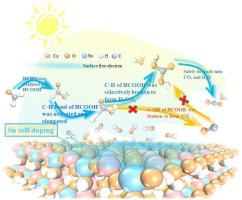Applied Catalysis B: Environment and Energy ( IF 20.2 ) Pub Date : 2020-06-09 , DOI: 10.1016/j.apcatb.2020.119214 Hong Wang , Xing’an Dong , Ruofei Tang , Jieyuan Li , Yanjuan Sun , Zhiming Wang , Ki-Hyun Kim , Fan Dong

|
Production of toxic intermediates is a vital issue that remains as the major hindrance to the advancement of photocatalysts for air purification applications. It is predicted theoretically that the reaction pathway of photocatalysis can be regulated effectively by the interactions between key intermediate reactant (e.g., HCOOH) and photocatalyst. Inspired by such prediction, a new strategy is proposed and validated to control the reaction pathway and the associated formation of toxic intermediates via selective breakage of chemical bonds of reactants. Herein, we introduce a Sn self-doped CaSn(OH)6 photocatalyst to realize safe and efficient photocatalytic oxidation of formaldehyde through selective breakage of C–H bonds in HCOOH formed as reaction intermediate. This photocatalyst altered the charge transfer direction to promote charge separation and to modify the surface distribution of electrons for the activation of the C–H bond. Through selective attack on the C–H bond by hydroxyl radicals, the reaction pathway was altered to avoid generation of toxic by-products (e.g., CO). The combination of in situ DRIFTS and continuous flow reaction tests indicated that enhanced photochemical destruction of formaldehyde can be achieved by effectively suppressing generation of toxic intermediates. The obtained Sn-CaSn(OH)6 reached a quantum efficiency of 1.43 × 10−8 molecules/photon and a high photocatalytic formaldehyde degradation activity of 79 %, much higher than those of Sn-CaSn(OH)6(m) (30 %) and pristine CaSn(OH)6 (no activity). This is attributed to the advantages of Sn self-doping that optimized the local electron structure. This research could provide new insight for pursuit of safe and efficient photocatalysts for air pollution control.
中文翻译:

有毒中间体的生产是一个至关重要的问题,仍然是阻碍空气净化应用中光催化剂发展的主要障碍。从理论上预测,通过关键中间反应物(例如,HCOOH)和光催化剂之间的相互作用,可以有效地调节光催化的反应路径。受这种预测的启发,提出并验证了一种新的策略,该策略可通过选择性破坏反应物的化学键来控制反应路径和相关的有毒中间体的形成。在这里,我们介绍了一个Sn自掺杂的CaSn(OH)6通过选择性破坏作为反应中间体的HCOOH中的C–H键来实现甲醛的安全有效的光催化氧化。这种光催化剂改变了电荷转移的方向,从而促进了电荷的分离并改变了电子的表面分布,从而激活了C–H键。通过羟基自由基对C–H键的选择性攻击,改变了反应途径,避免产生有毒副产物(例如,CO)。原位DRIFTS和连续流动反应测试的结合表明,可以通过有效抑制有毒中间产物的产生来增强对甲醛的光化学破坏。所获得的Sn-CaSn(OH)6达到1.43×10 -8的量子效率。分子/光子和79%的高光催化甲醛降解活性,远高于Sn-CaSn(OH)6(m)(30%)和原始CaSn(OH)6(无活性)。这归因于Sn自掺杂的优势,该优势优化了局部电子结构。这项研究可以为追求安全有效的光催化剂以控制空气污染提供新的见解。











































 京公网安备 11010802027423号
京公网安备 11010802027423号